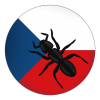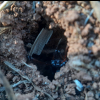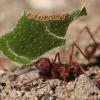Here is a thread to post all the interesting things you have observed about various species of ants that don't seem to be documented elsewhere. I'll start: Camponotus novaeboracensis nests in soil, Formica pallidefulva doesn't usually spin cocoons, even in the wild, Crematogaster forms the longest and best defined trails I have seen from any ant other than Tapinoma sessile, Dolichoderus is extremely common in far northern Wisconsin, Formica montana forms massive supercolonies with perhaps dozens of queens, Myrmica cf. punctiventris does a jittery Opisthopsis-like walk sometimes when threatened, and is also very good at playing dead, staying still even when poked. Camponotus pennsylvanicus will rip up moss for the purpose of building nest entrances, even when other materials are present and more easily accessible. I am also surprised at how tolerant ants are underground; different species will nest in what is essentially the same spot, apparently without fighting. I don't know how interesting this really is, but the other day I saw a Prenolepis nest entrance for the first time; it looked like they were digging out after having been sealing off for their summer dormancy.
Edited by Antennal_Scrobe, September 15 2019 - 12:35 PM.




























